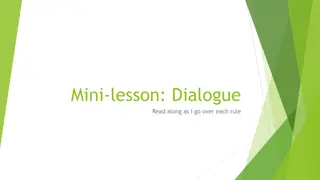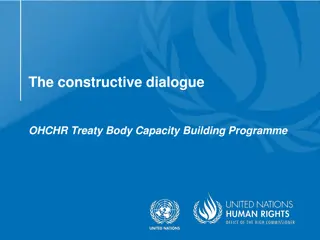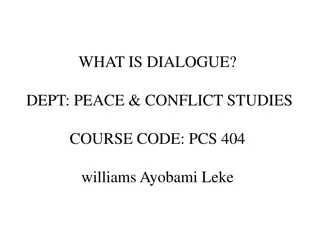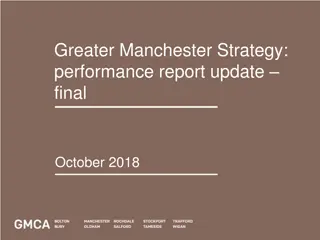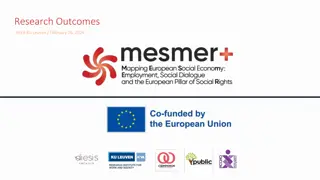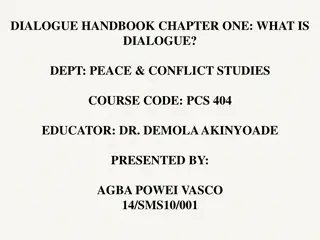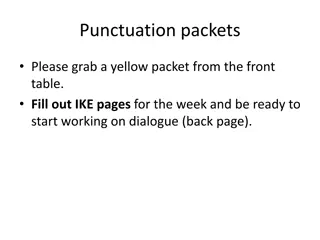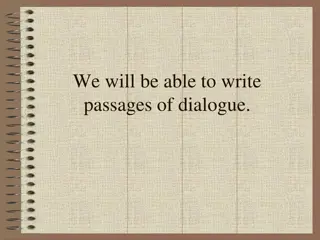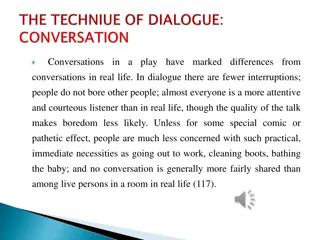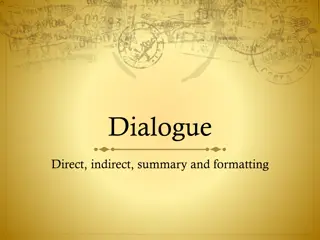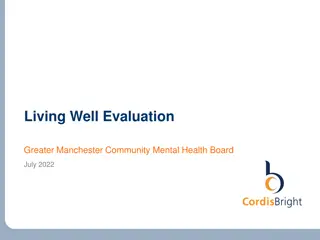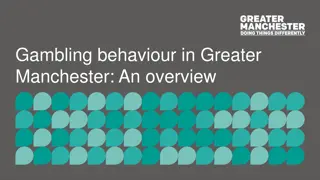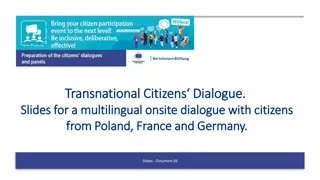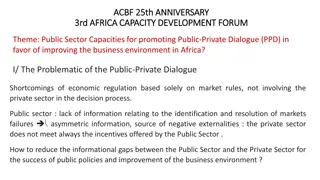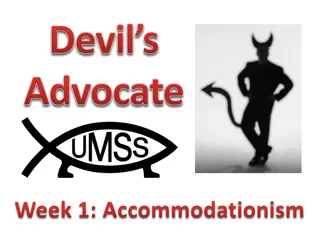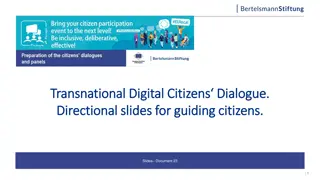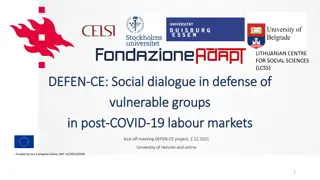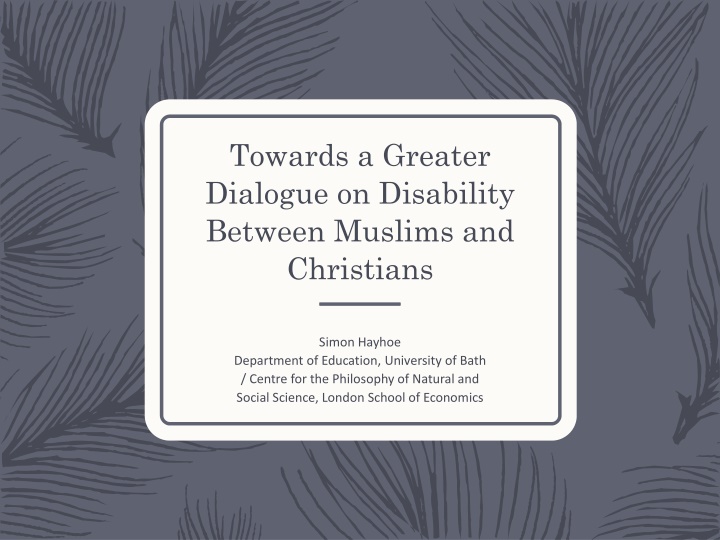
Dialogue on Disability between Muslims and Christians
Explore the attitudes of Western Christians and Islamic MENA Arabs towards disability, as shaped by religion, and delve into philosophical concepts of disability in Islam and Christianity. This research aims to foster an inter-cultural and inter-faith dialogue on disability issues.
Download Presentation

Please find below an Image/Link to download the presentation.
The content on the website is provided AS IS for your information and personal use only. It may not be sold, licensed, or shared on other websites without obtaining consent from the author. If you encounter any issues during the download, it is possible that the publisher has removed the file from their server.
You are allowed to download the files provided on this website for personal or commercial use, subject to the condition that they are used lawfully. All files are the property of their respective owners.
The content on the website is provided AS IS for your information and personal use only. It may not be sold, licensed, or shared on other websites without obtaining consent from the author.
E N D
Presentation Transcript
Towards a Greater Dialogue on Disability Between Muslims and Christians Simon Hayhoe Department of Education, University of Bath / Centre for the Philosophy of Natural and Social Science, London School of Economics
Initial Questions How much are Western Christian and Islamic MENA Arab attitudes to disability shaped by religion? Are there areas of interest on disability that can be discussed in both religions in order to form an inter-cultural and inter- faith dialogue on this issue?
Definitions of Islam and Christianity Pew Foundation (2012): 80% of people identify themselves with a religion - Islam and Christianity are two largest religions Definition of disability according to United Nations (2007) Encyclopedia Britannica s definitions of both religions (Islam, 2012; Christianity, 2012) Theology = Study of God Religion = Teaching of God Church / Mosque = Administration of religion
Grounded Theory: Cycle of Analysis Testing a hypothesis with new literature Examining trends in the literature Identifying classes of literature, developing a hypothesis
Ways of Interpreting the Literature in the Field Difficult to identify patterns (Johnson, 2008). comparison extrapolated from texts on single religions holistic concept of religion unrelated sociological factors. Only similar evaluations make medical and social comparisons (Vreede 2004; Miles, 1989, 2005; Porter 1999). Eventually three themes emerged
1. Philosophical Concepts of Disability in Islam and Christianity Most common form of literature on disability, Islam and Christianity Schism: Religious scholars focus of individual disabilities, whereas secular scholars discuss a social theory of all disabilities (e.g. Braddock & Parish, 2001; Barnes & Mercer 2003; Oliver, 1989) Traditional lack of holistic conceptualization of disability in law and social discourse (e.g. Warnock et. al., 1978) Disability a relatively modern concept
Two important philosophical elements a) Biblical and Islamic jurisprudence to a form of spiritual healing (Ghaly, 2008; Barnes, Plotnikoff, Fox & Pendleton, 2000; Frohock, 1992) b) Looking to sacred texts to find meaning in disability, or family members disabilities (Creamer, 2012; Morad, Nasri & Merrick, 2001; Ghaly, 2010; Tan, 1998; Hersh & Scotti Hughes, 2006)
2: Changing Attitudes to Disability in Islam and Christianity Emphasis on historical medical and educational moral treatments, disability as abnormality (Porter, 1999, 2004; Miles, 1995) Arab Islamic and Western Christian historical notions of charity and institutionalization guided by religion (Porter, 1999, 2004; Foucault, 2001; Barasch, 2001; Hayhoe, 2008; Paulson, 1987) E.g. Catholic to Protestant: changes in attitudes to what are now regarded as the human (Porter, 2004)
3. Attitudes to Disability From Personal and Social Experience Highlights a relatively small difference between disability in Christianity and Islam on disability Ghaly (2010) finds that Islam has two approaches to healing and disability, which are outlined by jurisprudence: scientific healing: which is based on contemporary scientific, medical healing spiritual healing: which is based on the use of texts, many of which are from the Qu ran. Growing movement for Islam to forge its own spirituality (Gaventa, 2008)
Western Christianity: Growing literature on disability as a spiritual concept (Kaye & Raghavan, 2002; Berinyuu, 2004; Reyes-Ortiz, 2006; Schulz, 2005; Gaventa & Coulter, 2005) Evidence: Two ethnographic studies from North America People become aware of spirituality and sympathize more with disabilities via own disability (Treloar, 2002; McColl et. al., 2000)
Broken body of Jesus as central image As Islam rejects imagery as iconography, Christian spirituality differs as it reflects empathy with imagery of imperfection & sacrifice E.g. Hull (2003a): the foremost image of its faith is the broken body of Jesus on the cross God disembodied and criticized need to picture face of God (Hull, 2003c) Kutz & Ketcham (1993): imperfection a form of spiritualism However, paternal approach leads to hegemony of care (Hull, 2003b)
Themes for the Axial Coding Phase No fundamental differences between Islam and Christianity on disability This analysis was broken into two themes that appeared to be common to the three topics that arose from the data: The notion of charity and caring that was present in Islam and Christianity The cause of disability from either sin or a gift from God
Factor 1: Sin and Disability Ghaly (2010) and Rispler-Chaim (2007): Early Arabic Islamic scholars see a link between parents miss-deeds and children s disabilities Gaventa & Coulter (2001): Moral ambiguities towards disability in parts of the Middle East. Intellectual Disabilities (ID) the work of Jinn Children with ID can bring shame on families Ameen (2005): People with disabilities have been afflicted with Jinn through acts of witchcraft pre-Islamic religion - in conflict Qu ran
Qur'an does not relate Jinn to disability: (55:1) God made the Jinn from smokeless fire (71) Jinn deceptive - undermines word of God Ghaly (2009, 2010), Chaleby (1996) Murad & Gordon (2002), Yasser A Elsayed, Al-Zahrani & Rashad (2010), El-Hassan (1986): There is a difference in Sharia law in moral attitudes to those with ID or mental health problems In law, both morally incompetent , and not treated as harshly as unimpaired people
Contradiction between secular and Christian interpretation Barnes & Mercer, (2003): Jesus asks blind man what sin he committed Fritzon (2001) and Hull (2001a): John 9:1-5 describes Jesus on blindness not caused by sin And as Jesus passed by, he saw a man which was blind from his birth. And his disciples asked him, saying, Master, who did sin, this man, or his parents, that he was born blind? Jesus answered, Neither hath this man sinned, nor his parents: but that the works of God should be made manifest in him. I must work the works of him that sent me, while it is day: the night cometh, when no man can work. As long as I am in the world, I am the light of the world.
Gleeson (1999) and Schipper (2005): Individual statements about negative interpretations of the Bible too simplistic Fritzon (2001): Deuteronomy 27:18 Cursed be he that maketh the blind to wander out of the way. And all the people shall say, Amen. Hull (2001a): Could a Blind Man Have Become a Disciple? Many interpretations on blindness Less scrutiny of the Qur an by Secular critics
2. Charity and Faith Christianity and Islam espouse acts of charity (Bhatty, Moten, Tawakkul & Amer, 2009; Fitzron, 2001) Almusa (2010, 2003), Bhatty, Moten, Tawakkul & Amer (2009), ElHessen (2006), Bazna & Hatab (2005), Ghaly (2009): Equality for people with disabilities, as with all disadvantaged people, is fundamental to Islam Does not judge people on physical or economic strength or superiority, but on piety to Islam
ElHessen (2006): Islamic scripture regards ill and impaired children as a gift from God Spirit of Ibsan: child tests parent s compassion Morad, Nasri & Merrick (2001): Qu ran emphasizes wealthy and non-disabled Muslims obliged to conduct positive acts Fritzon (2001): Bible is positive towards people with disabilities Responsibility of Christians to treat all people equally - all made equally in God s image
Unambiguous passages in Bible and Quran rewarding acts of charity / inclusion / acts of equality. For example: Attend to your prayers and render the alms levy. Whatever good you do shall be recompensed by God. God is watching all your actions. Qu ran 2:110 And above all things have fervent charity among yourselves: for charity shall cover the multitude of sins. 1 Peter 4:8 Which have borne witness of thy charity before the church: whom if thou bring forward on their journey after a godly sort, thou shalt do well 3 John 1:6
Differences in the Method of Charity Qu ran distinguishes behaviour charity and alms. Bibles espouses charity as behaviour and education e.g. Luke 10, parable of good Samaritan Whosoever therefore shall break one of these least commandments, and shall teach men so, he shall be called the least in the kingdom of heaven: but whosoever shall do and teach them, the same shall be called great in the kingdom of heaven. 1 Matthew 5:19
Selective coding
Hypothesis As difference between Islam and Christianity in charity minimal, hypothesis reflected it As the Bible and Qu ran have similar approaches to charity, approaches to current charitable institutions will be similar in MENA and Western societies. Schuelka (2012), Porter (1999): Different emphasis in Christianity and Islam on medical treatment
Islam Arabic Islamic cultures focus on acts within family, particularly mothers and sisters (Frank, 1989; Crabtree, 2007). Terpstra (2011): Prior to 1700 institutional charities found in Ottoman and Persian territories, based on models of Europe Influenced by Christian traders GCC countries largely based on Western models (Gaad, 2011)
Christianity Porter (1999), Ghaly (2010): Institutions related the Islamic medical treatment in period before the Enlightenment Western Christian infirmaries more numerous Abbeys involved in medical treatment - crusaders with eyes gouged out by forces of Salidin taught a trade (Selway & Ashman, 1998). Christian emphasis on treatment root of medical practices (Porter 1999, 2003)
Attitudes Attitudes to disability still affected by religions Discussions on religious beliefs significantly influence Arab and Western cultural attitudes Relies on theological notion of impairment Limited literature on institutions in 19th and 20th Century Islamic Arab culture Institutions in MENA region have been inherited largely from Western Christian philosophy More research needed on Islamic institutions
Abrams, J.Z. (2007). Misconceptions about disabilities in the Hebrew Bible. Journal of Religion, Disability & Health, 10, 3, 73-84. Ahmed, D.A.A. (2007). Gender, disability and Islam: living with visual impairment in Bahrain. (PhD Thesis) Warwick University, UK. Akaddaf, F. (2001). Application of the United Nations convention on Contracts for the International Sale of Goods (CISG) to Arab Islamic countries: Is the CISG compatible with Islamic law principles? Pace International Legal Review, 13, 1-58. Al-Aoufi, H., Al-Zyoud, N. & Shahminan, N. (2012) Islam and the cultural conceptualisation of disability. International Journal of Adolescence and Youth, 17, 4, 205-219. Albrecht, G.L. (2006) Encyclopaedia of disability. Thousand Oaks, CA: Sage Publications. Ali, Z., Fazil, Q., Bywaters, P., Wallace, L. & Singh, G. (2001). Disability, ethnicity and childhood: A critical review of research. Disability & Society, 16, 7, 949-967. Almusa, A. (2004). Blindness in Islam. Paper Presented to the CEC Conference, April 2004, New Orleans, US. Ameen, A.K.I. (2005). The jinn and human sickness: Remedies in the light of the Qur'aan and Sunnah. Riyadh: Darussalam Publications. Banda, M., Ombaka, E., Logez, S. & Everard, M. (2006). Multi-country study of medicine supply and distribution activities of faith-based organizations in sub-Saharan African countries. Geneva: World Health Organisation.
Barasch, M. (2001). Blindness: The history of a mental image in Western thought. London: Routledge. Barnes, C. & Mercer, G. (2003). Disability. Cambridge, UK: Polity Press. Barnes, L.L., Plotnikoff, G.A., Fox, K. & Pendleton, S. (2000) Spirituality, religion, and pediatrics: Intersecting worlds of healing. Pediatrics 106, 899 -908. Bazna M.S. & Hatab, T.A. (2005). Disability in the Qur'an. Journal of Religion, Disability & Health, 9, 1, 5-27. Bazna, M.S. & Kim Reid, D. (2009). Rethinking learning disabilities in Kuwait. A more humanistic and culturally appropriate view. Retrieved from http://www.nl.edu/dse/docs/Bazna%20and%20Reid.Rethinking%20learning%20disabilities%20in%20Kuwait.pdf. Berinyuu, A. (2004). Healing and disability. International Journal of Practical Theology, 8, 2, 202-211. Betten, H. (2009). The earliest history of deaf education in Europe. Retrieved from http://www.taubenschlag.de/cms_pics/THE%20EARLIEST%20HISTORY%20OF%20DEAF%20EDUCATION%20IN%20EUROPE, %20article.pdf. Bhatty, I., Moten, A.A., Tawakkul, M., & Amer, M. (2009). Disability in Islam: Insights into theology, law, history and practice. In C.A. Marshall, E. Kendal, M.E. Banks, R.M.S. Gover (Eds.). Disabilities: Insights from across fields and around the world. Wesport, CT: Greenwood. Braddock, D.L., & Parish, S.L. (2001). An institutional history of disability. In G. L. Albrecht, K. D. Seelman, & M. Bury (Eds.). Handbook of disability studies. London: Sage. Byrd, E.K. (1990). A study of biblical depiction of disability. Journal of Applied Rehabilitation Counseling, 21, 4, 52-53.
Chaleby, K.S. (1996). Issues in forensic psychiatry in Islamic jurisprudence. Journal of the American Academy of Psychiatry and the Law, 24, 1, 117-124. Chand, S. & Patterson, J. (2007). Faith-based models for improving maternal and newborn health. In Soul Beat Africa. Retrieved from http://www.soulcity.org.za/. Crabtree, S.A. (2007). Maternal perceptions of care-giving of children with developmental disabilities in the United Arab Emirates. Journal of Applied Research in Intellectual Disabilities, 20, 247 255. Christianity. (2012). In Encyclopaedia Britannica Online. Retrieved from http://www.britannica.com. Creamer, D.B. (2012). Disability theology. Religion Compass, 6, 339 346. Cusack, C.M. (1997). Medieval Christian attitudes to disability. Disability and Rehabilitation, 19, 10, 414-419. Cuskelly, M., Hauser-Cram, P. & Van Riper, M. (2008). Families of children with Down syndrome: What we know and what we need to know. Down Syndrome Research and Practice, 12, 3, 105-113.
Elsayed, Y.A., Al-Zahrani, M. & Rashad, M.M. (2010). Characteristics of mentally ill offenders from 100 psychiatric court reports. Annals of General Psychiatry, 9, 4, Retrieved from http://www.biomedcentral.com/content/pdf/1744-859X-9- 4.pdf. Fitzgerald, J. (1997). Reclaiming the whole: Self, spirit, and society. Disability and Rehabilitation, 19, 10, 407-413. Foucault, M. (2001). Madness and civilization. London: Routledge Classics. Frank, A. O. (1989). The family and disability - some reflections on culture: Discussion paper. Journal of the Royal Society of Medicine, 82, 666-668. Fritzon, A. (2001). People with disabilities in the Bible: Who are they and what can we learn from them? ECHOES, 19, Retrieved from http://www.wcc-coe.org/wcc/what/jpc/echoes/echoes-19-06.html. Frohock, F.M. (1992). Healing powers: Alternative medicine, spiritual communities, and the state. Chicago, IL: University Of Chicago Press. Gaad, E. (2011). Inclusive education in the Middle East. London: Taylor & Francis. Gaventa, W. (2008). The unity in diversity, complexity, and disability. Journal of Religion, Disability & Health, 12, 2, 101-104. Gaventa, W. C. & Coulter, D. (2001). Spirituality and intellectual disability: International perspectives on the effect of culture and religion on healing body, mind and spirit. Binghamton, NY: Haworth Pastoral Press. Ghaly, M. (2006). Writings on disability in Islam: The 16th-century polemic on Ibn Fahd's "al-Nukat al-Ziraf". The Arab Studies Journal, 14, 1, 9-38.
Ghaly, M. (2008). Physical and spiritual treatment of disability in Islam: Perspectives of early and modern jurists. Journal of Religion, Disability & Health, 12, 2, 105-143. Ghaly, M. (2010). Islam and disability: Perspectives in theory and jurisprudence. New York: Routledge. Glaser, B.G., & Strauss, A.L. (1967). The discovery of grounded theory: Strategies for qualitative research. Chicago, IL: Aldine Publishing Company. Gleeson, B. (1998). Geographies of disability. London: Routledge. Goffman, E. (1991). Asylums: Essays on the social situation of mental patients and other inmates. London: Penguin. Gordon, H. & Murad, I. (2002). Psychiatry and the Palestinian population. The Psychiatrist, 26, 28-30. Hasnain, R., Cohon Shaikh, L. & Shanawani, H. (2008). Disability and the Muslim perspective: An introduction for rehabilitation and health care providers. Buffalo, New York: Center for International Rehabilitation Research Information and
Hersh, E. & Scotti Hughes, R. (2006). The role of suffering and disability. Journal of Religion, Disability & Health, 9, 3, 85-92. Hull, J.M. (1992). Touching the rock: An experience of blindness. London: Vintage. Hull, J.M. (2001a). In the beginning there was darkness: A blind person's conversations with the Bible. Norwich, UK: SCM Press. Hull, J.M. (2001b). Could a blind person have been a disciple of Jesus? Ministerial Formation, 92, 20-21. Hull, J.M. (2002). Sight to the inly blind ? Attitudes to blindness in the hymnbooks. Theology, 827, 333-341. Hull, J.M. (2003a). The broken body in a broken world: A contribution to a Christian doctrine of the person from a disabled point of view. Journal of Religion, Disability and Health, 7, 4, 5-23. Hull, J.M. (2003b). A spirituality of disability: The Christian heritage as both problem and potential. Studies in Christian Ethics, 16, 2, 21-35. Hull, J.M. (2009). Lord I was deaf . Images of disability in the hymnbooks. In S.
Jawad, R. (2009). Religion and social welfare in the Lebanon: Treating the causes or symptoms of poverty? Journal of Social Policy, 38, 1, 141-156. Kaye, J. & Raghavan, S.K. (2002). Spirituality in Disability and Illness. Journal of Religion and Health, 41, 3, 231-242. Koenig, H.G., McCullough, M.E. & Larson, D.B. (2001) Handbook of religion and health. New York: Oxford University Press. Kors, A. & Peters, E. (1978). Witchcraft in Europe, 1100-1700. Philadelphia, PA: University of Pennsylvania Press. Kurtz, E. & Ketcham, K. (1993). The spirituality of imperfection. London: Bantam Books. Larsson, G. (2011). Islam and disability: perspectives in theology and jurisprudence. Islam and Christian Muslim Relations, 22, 3, 367-368. Lewis, H.M. (2002) A critical examination of the church and deaf people: Toward a deaf liberation theology. (PhD Thesis) Birmingham University, UK. Llewellyn, A. & Hogan, K. (2000). The use and abuse of models of disability. Disability & Society, 15, 1, 157-165. MacKinlay, E. (2008). Ageing, disability and spirituality: Addressing the challenge of disability in later life. London: Jessica Kingsley Publishers. McColl, M.A., Bickenbach, J., Johnston, J., Nishihama, S., Schumaker, M., Smith, K., Smith, M. & Yealland B. (2000). Changes in spiritual beliefs after traumatic disability. Archives of Physical Medicine and Rehabilitation, 81, 6, 817 823.
Miles, M. & Hossain, F. (1999). Rights and disabilities in educational provisions in Pakistan and Bangladesh: Roots, rhetoric, reality. In F. Armstrong & L. Barton (Eds.). Disability, human rights and education: Cross-cultural perspectives. Buckingham, UK: Open University Press. Miles, M. (1989). Information based rehabilitation for third world disability. Social Science and Medicine, 28, 3, 207-210. Miles, M. (1992). Concepts of mental retardation in Pakistan, toward cross-cultural and historical perspectives. Disability, Handicap & Society, 7, 3, 235-256. Miles, M. (1995). Disability in an eastern religious context: Historical Perspectives. Disability & Society, 10, 1, 49-70. Miles, M. (2002a). Some historical texts on disability in the classical Muslim world. Journal of Religion, Disability & Health, 6, 2, 77-88. Miles, M. (2002b). Some influences of religions on attitudes towards disabilities and people with Disabilities. Journal of Religion, Disability & Health, 6, 2, 117-129. Morad M., Nasri, Y. & Merrick J. (2001): Islam and the person with intellectual disability. Journal of Religion, Disability & Health, 5, 2, 65-71.
Oliver, M. (2001). Disability issues in the postmodern world. In L. Barton (Ed.). Disability, politics & the struggle for change. London: David Fulton Publishers. Olyan, S.M. (2008). Disability in the Hebrew Bible: Interpreting mental and physical differences. Cambridge: Cambridge University Press. Paulson, W. R. (1987). Enlightenment, romanticism and the blind in France. Princeton, NJ: Princeton University Press. Porter, R. (1999). The greatest benefit to mankind: A medical history of humanity from antiquity to the present. London: HarperCollins. Porter, R. (2004). Flesh in the age of reason: The modern foundations of body and soul. London: Penguin. Reyes-Ortiz, C.A. (2006). Spirituality, disability and chronic illness. Galveston, TX: Sealy Center on Aging, University of Texas Medical Branch, Special Section: Spirituality/Medicine Interface Project. Rispler-Chaim, V. (2007). Disability in Islamic law. Dordrecht, Netherlands: Springer. Rose, A. (1997). "Who causes the blind to see": Disability and quality of religious life. Disability & Society, 12, 3, 395-405.
Schulz, E.K. (2005). Spirituality and disability: An analysis of select themes. Occupational Therapy in Health Care, 18, 4, 57-83. Selway, D. & Ashman, A. (1998). Disability, religion and health: A literature review in search of the spiritual dimensions of disability. Disability & Society, 13, 429 439. Serneels, P., Montalvo J.G., Pettersson, G., Lievens, T., Butera J.D. & Kidanu A. (2010). Who wants to work in a rural health post? The role of intrinsic motivation, rural background and faith-based institutions in Ethiopia and Rwanda. Bulletin of the World Health Organization, 88, 342-349. Stienstra, D. (2002). The intersection of DISABILITY and race/ethnicity/official language/religion. Paper presented to the seminar Intersections of Diversity, 8th March 2002, Winnipeg, Canada. Swinton, J. (1997). Restoring the image: Spirituality, faith, and cognitive disability. Journal of Religion and Health, 36, 1, 21-28. Tan, S.A. (1998). The disabled Christ. Transformation, 15, 4, 6-14. Taubes, T. (1998). Healthy avenues of the mind : Psychological theory building and the influence of religion during the era of moral treatment. The American Journal of
Thurer, S. (1980). Disability and monstrosity: A look at literary distortions of handicapping conditions. Rehabilitation Literature, 41, 12-15. Treloar, L.L. (2000). Spiritual beliefs, response to disability, and the Church-part 2. Journal of Religion, Disability & Health, 4, 1, 5-31. Treloar, L.L. (2002) Disability, spiritual beliefs and the church: The experiences of adults with disabilities and family members. Journal of Advanced Nursing 40, 5, 594 603. Underwood, L.G. (1999). A working model of health: Spirituality and religiousness as resources: Applications to persons with disability. Journal of Religion, Disability & Health, 3, 3, 51-71. United Nations (2007) E-nable: What is disability and who are persons with disabilities? http://www.un.org/esa/socdev/enable/faqs.htm#definition. Vreede, A. (2004). Traditional concepts, attitudes and practices regarding disability. Amsterdam: Foundation for Comparative Research. Warnock, H. M. et. al. (1978). Special educational needs: Report to the committee of enquiry into the education of handicapped children and young people. London: HMSO. Watts, G. (2012). The perception of references to disability in the Bible. Australian


